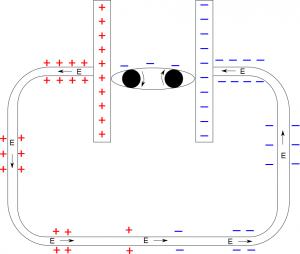This is an old revision of the document!
Surface Charge Gradients
In the previous page of notes, we showed that there must be some charges along the surface of a wire and they must be arranged in a gradient. We call these charges along the surface of the wire surface charges. The surface charges create an electric field in the wire, which then pushes electrons through the wire to create a current. In this page of notes, we will dig a little deeper into what a gradient of surface charges actually is and how we represent that gradient on a drawing.
What is a gradient?
A gradient is simply a change in the amount of something. For example, you may have seen a color gradient (like the one shown at the right), where you start with a single color that slowly fades to white. In this case, the color is what is changing, so we call it a “color gradient.” Similarly, when we talk about a surface charge gradient on a wire, this means that we are talking about a change in the amount of charge along the wire. The word change here is really important. It is not simply that there are a lot of charges on the surface of the wire. For a surface charge gradient to exist, there must be areas on the wire with a lot of positive charge, areas with less positive charge, areas with almost no charge, areas with less negative charge, and areas with a lot of negative charge. The key to figuring out what is happening in the wire is to determine where your positive charge is concentrated, where your negative charge is concentrated, and how the charges change in between.
How do we represent a surface charge gradient?
It would be impossible to actually count or draw every single electron along the surface of a wire. There are simply too many, and it would make our picture too messy to be useful. Instead, we draw a small representative amount of charges on our picture. For example, if we go back to the picture with the battery and surface charges:
There are a few things to notice:
- We have drawn a small amount of charges on the surface of the wire. For example, in the top right corner, we have drawn a total of eight negative signs on the outside of the wire. This does not mean that there is exactly eight electrons on the wire. Instead, this just shows that we expect this area of the wire to have a large concentration of negative charge. There is no particular reason why we drew eight - we could have picked 12 or 6 or any other number to start with. The important part is that there are more negative signs in this area than any other part of the wire.
- As we move along the wire on the right side, the number of negative decreases from 8 to 6 to 4 to 2. This represents the gradient of surface charges. As we move along the wire, we expect there to be a lot of negative surface charges near the battery, and as you get further away along the wire, there should be fewer and fewer negative surface charges. Remember, the change in the amount of charge is what makes it a gradient. Similarly, as we approach the positive side of the battery, we draw 2 to 4 to 6 to 8 positive signs to represent the increase in the amount of positive surface charges.
